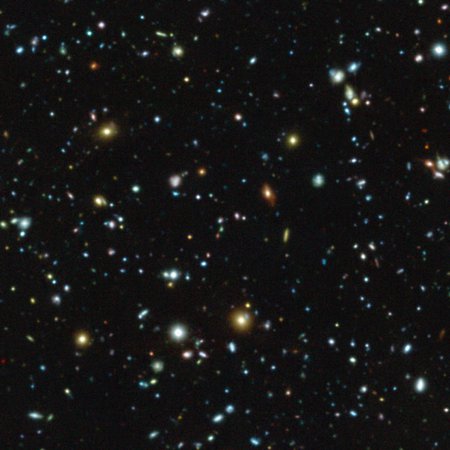New 3D view of the Milky Way reveals the central Galactic bar

Display of Gaia data combined with other surveys and StarHorse code over an illustration of the Milky Way.
Credit: Data: ESA/Gaia/DPAC, A. Khalatyan (AIP) & StarHorse team; Galaxy map: NASA/JPL-Caltech/R. Hurt (SSC/Caltech)By combining the results from ESA’s Gaia mission’s second data release (DR2) with complementary observations, scientists under the leadership of the Leibniz Institute for Astrophysics Potsdam (AIP) and the University of Barcelona present a map of our Milky Way that shows the central bar structure.
With the use of additional optical and infrared photometry from ground-and space-based telescopes, scientists of AIP and the Institute of Cosmos Sciences of the University of Barcelona have recently determined new distances, stellar properties and interstellar dust extinctions for about 150 million stars in our Galaxy. This multi-wavelength approach especially allows for a more accurate mapping of the most distant regions of the Milky Way, extending the three-dimensional view of the Milky Way beyond previous works and for the first time clearly mapping the central Galactic bar.
“We looked in particular at two of the stellar parameters contained in the Gaia data: the surface temperature of stars and the ‘extinction’, which is basically a measure of how much dust there is between us and the stars, obscuring their light and making it appear redder,” says Dr. Friedrich Anders from University of Barcelona, lead author of the new study. “These two parameters are interconnected, but we can estimate them independently by adding extra information obtained by peering through the dust with infrared observations.”
The team combined the second Gaia data release with several infrared surveys using a computer code called StarHorse, developed by co-author Anna Queiroz, PhD student in the Milky Way and Local Volume group at AIP, and collaborators. The code compares the observations with stellar models to determine the surface temperature of stars, the extinction and an improved estimate of the distance to the stars. Dr. Arman Khalatyan, member of the Supercomputing and E-Science group at the AIP and second author of the article, underlines that “in total, the computation would have taken 19 years on a single computer. And with the growing amount of data, even bigger efforts will be necessary in the future.” The computations were conducted at the cluster facility of AIP.
As a result, the astronomers obtained much better determination of the distances to about 150 million stars – in some cases, the improvement is up to 20% or more. This enabled them to trace the distribution of stars across the Milky Way to much greater distances than possible with the original Gaia data alone. “With the second Gaia data release, we could probe a radius around the Sun of about 6500 light years, but with our new catalogue, we can extend this ‘Gaia sphere’ by three or four times, reaching out to the center of the Milky Way,” explains co-author Dr. Cristina Chiappini, staff scientist in the AIP's Milky Way and Local Volume group.
There, at the center of our galaxy, the data clearly reveals a large, elongated feature in the three-dimensional distribution of stars: the galactic bar. “We know the Milky Way has a bar, like other barred spiral galaxies, but so far we only had indirect indications from the motions of stars and gas, or from star counts in infrared surveys. This is the first time that we see the galactic bar in 3D space, based on geometric measurements of stellar distances,” says Anders.
“Ultimately, we are interested in galactic archaeology: we want to reconstruct how the Milky Way formed and evolved, and to do so we have to understand the history of each and every one of its components,” adds Chiappini. “It is still unclear how the bar – a large amount of stars and gas rotating rigidly around the center of the galaxy – formed, but with Gaia and other upcoming surveys in the next years we are certainly on the right path to figure it out.”
Next Gaia data releases & follow-up spectroscopic surveys
Looking ahead, Queiroz is excited that "with the upcoming Gaia data release, which will also include low-resolution spectra for billions of stars, we can produce even better Galactic maps, possibly reaching the other side of the Galactic disc." The third Gaia data release, currently planned for 2021, will include greatly improved distance determinations for a much larger number of stars, and is expected to enable progress in our understanding of the complex region at the center of the Milky Way.
Chiappini adds: "Spectroscopic follow-up surveys using dedicated earthbound telescopes will provide complementary information, in particular radial velocities and detailed chemical composition fingerprints for many millions of stars. Combined with Gaia, these surveys, among them the 4-metre Multi-Object Survey Telescope (4MOST) at the European Southern Observatory and the WEAVE survey at the William Herschel Telescope in La Palma, will allow us to unfold the assembly history of the Milky Way in a much more detailed fashion."
Further information
Veröffentlichung
F. Anders, A. Khalatyan, C. Chiappini, A. Queiroz, et al. (2019), Astronomy and Astrophysics, “Photo-astrometric distances, extinctions, and astrophysical parameters for Gaia DR2 stars brighter than G = 18”
https://doi.org/10.1051/0004-6361/201935765
ESA press release
http://www.esa.int/Our_Activities/Space_Science/Gaia/Gaia_starts_mapping_our_galaxy_s_bar
Data access
https://data.aip.de/projects/starhorse2019.html (doi:10.17876/gaia/dr.2/51)
Images
Display of Gaia data combined with other surveys and StarHorse code over an illustration of the Milky Way.
Big screen size [1000 x 1000, 1000 KB]
Original size [1024 x 1024, 1010 KB]



